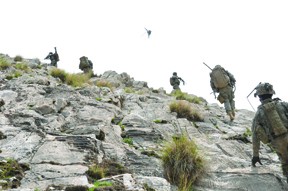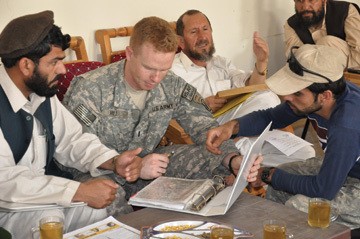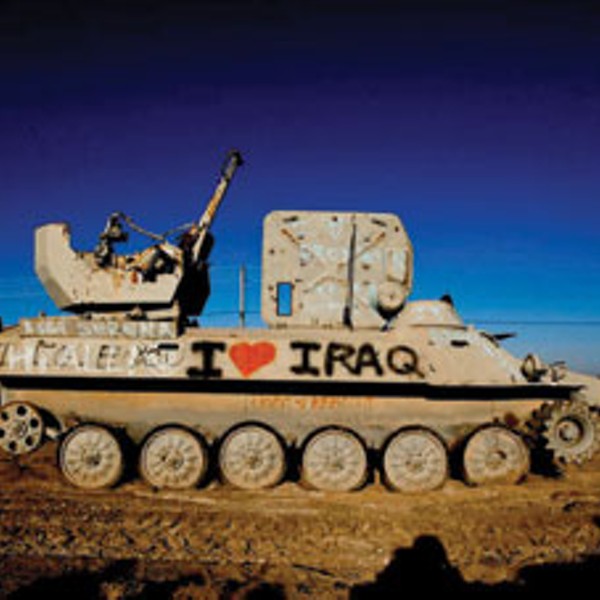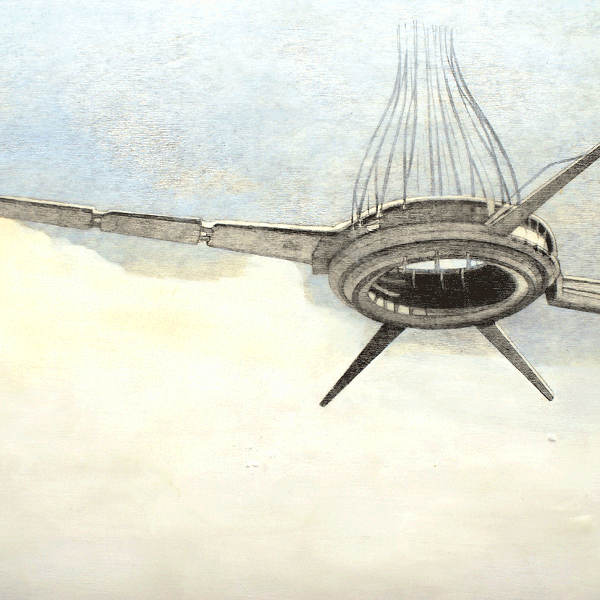In mid-December, 2nd Platoon, Able Company, arrived with a full infantry platoon—two dozen soldiers—enough to patrol up into the volatile Badel Valley of their new home. The valley, as most in Kunar, is filled with subsistence farmers living in rock houses or large mud-walled compounds. The farmers wake up early to tend to their fields, goats, and donkeys. Calls to prayer ring out in the mornings, days, and evenings from mosque loudspeakers. Boys seem to play a constant game of cricket in the fallow fields and most girls of a certain age hide their faces. The roads are good at the mouth of the valley thanks to US paving efforts, but soon they start to give way to rocky donkey trails where the distinct crackling of gunshots remind everyone that these villagers do not trust the Afghan government and they don’t like the presence ofUS soldiers.
Moving mostly on foot, 2nd Platoon scales mountainsides in search of flat spots to put outposts, most of which will not be approved by higher command. They observe illegal wood caches that they really can’t do anything about, and they try to engage with village leaders, some of whom won’t come out to meet them for fear of Taliban reprisals. The soldiers feel they’re hampered from engaging in a more direct fight by the Army’s new Counter-Insurgency (COIN) doctrine and rules of engagement—both devised to prevent civilian casualties and help win over the people.
Calling their enemy alternatively mountain fighters and/or Taliban, the truth of the matter is none of the guys on the ground really know if it’s Taliban attacking them, foreign fighters from Pakistan, smugglers, or renegade tribes. The Taliban serves as a euphemism for the “bad guys.” What the troops do know is that most attacks on the outpost come just after dusk, and that if they haven’t been attacked in a few days, it usually means that a more coordinated attack—shooting from multiple positions—is coming.
“Just waiting to get hit is really nerve wracking,” said 24-year-old Sgt. David Lopez. “We haven’t been hit in three days. Right now I’m like, ‘Dang man, what are they planning?’ Once you get hit, you’re like, `Thank God, man, that’s it, we should be good for another day and half.’”
View From the Hill
I last visited the Badel Valley in August 2009. The air was heated with summer humidity and tension surrounding the upcoming national elections. Gunshots, or “harassing fire” as the 10th Mountain soldiers call it, regularly rang down from the surrounding mountaintops. In the six months that have passed between my first visit to Badel and now, some things have changed, but much has not. “Our purpose is to provide security for surrounding towns,” said 24-year-old Sgt. Michael Dolce, who was deployed to Iraq in 2007 where he was wounded by an improvised explosive device. “Our goal is to push out the Taliban. But a lot of times we hang around the outpost doing dumb stuff like filling Hesco [sand-filled cardboard shield] barriers and using the little wood we have to build better shelters.”
“I tell my wife we pull a lot of guard, meet Afghans, give them stuff,” chimed in Private Finch, a 21-year-old heavy machine gunner. “That we’re trying to turn Afghanistan from a thirdworld country to a country we could visit some day.”
In the early morning hours the first day after my arrival, I accompanied a squad of 2nd Platoon’s infantrymen on a patrol through the wheat fields up to a gumdrop-shaped hill in the distance. Climbing it in darkness, they set up defensive positions overlooking the town of Subagar. Some days the troops take fire from the town, which lies on one side of the hill. On the other side sits a cache of smuggled wood. By Afghan law, wood smuggling is illegal, but Afghan authorities are hesitant to impound such caches because of the hidden powerbrokers that control the trade. An hour after sunrise, the squad began to take fire. We scrambled down the mountain, one team covering our backs as another surged forward, and marched, sweat-drenched, back inside the razor wire of COP Badel.
That was my first patrol, but counter-insurgency as now practiced by most infantry units in Afghanistan means moving the opposite way from the enemy. Units are more likely to patrol down to district centers and engage the fledgling Afghan district governments and influential elders in something called Key Leader Engagements (KLE). A ubiquitous term, KLE engagements in Kunar are usually initiated by drinking flavorless chai tea with an Afghan subgovernor or police chief, and exchanging formalities such as inquiring how their families are doing before getting down to the business of how to move the district’s Coalition-funded projects forward.
In the eyes of the young troops—already combat veterans in their own right—this amounts to a lot of sitting around. But 2nd Platoon’s commander, 24-year-old Lt. Richard Hill, has learned how to make best use of KLEs. “At first I was trying to accomplish a checklist of things, and a lot got lost in the shuffle. Now I just focus on one agenda, whether it’s the quarterly budget or planning a veterinarian clinic day.”
Most soldiers pulling guard duty in 100-degree heat outside the district center say they would rather be up in the valley, even if it means drawing the fire of mountain tribes who may or may not be fully Taliban. They say that’s their job.
Budgets over Bullets
The infantrymen’s frustration is apparent in all of this. “This deployment, it’s like we’re doing the whole COIN thing, and we’re concentrated way too much into it,” said Sgt. Lopez. “These people are going to take and take and take. They’re not gonna help you. They’re just going to take care of themselves. It’s like we’re getting bullied and pushed more and more out of the valleys,” added Lopez, referring to the recent closing of the Korengal Outpost located several valleys westward. The closing of Korengal was seen as a kind of surrender among many of the young veterans whose friends had fought and died there in 2007-08.
But the young officers of Able Company have been indoctrinated into a whole new approach to the conflict—prioritizing the avoidance of civilian casualties while doling out money as an incentive to working with the coalition instead of the Taliban. Gone are the days of measuring successes by the gobs of money given to quasi-corrupt officials—the burning of funds so quickly, some commanders complained, would only increase local corruption. The new approach of Commander Emergency Response Program allocated funding is to carefully distribute US money into the district’s quarterly budget pot, with the stipulation that the local government incorporate better development planning and more democratic practices using a system of elders elected from area villages as decision makers rather than the Afghan equivalent of the smoke-filled back room meeting of powerbrokers and warlords.
According to Able Company’s Commander, 27-year-old Capt. Joe Snowden, in Able Company’s area of operations—the three southern districts of Kunar—the reality is that the bulk of the money has been spent on projects that are the “easiest to allocate,” like local wells. This is done in order “to gain quick credibility with the elders as long as they can ensure security.” In other words, the safest places get the money quickest, and the more dangerous places get a little bit of money in the hopes they can be turned around. On the nuts and bolts district level, it still appears difficult for Afghans to trust the Americans at their word, which is that if the Afghans comply with the system, another quarterly budget allocation will follow. The reality is that too many units have come and gone here, leaving a trail of unfinished projects.
Kunari Afghans favor their traditional decision-making Shura, or council of elders over the complex US system advocating for more voices to be heard on the all-important budgeting process. For example, the Narang subgovernor claimed his district’s various Shuras agreed that the entire quarterly budget be spent on two retaining walls and a water pipe scheme. The price of these three projects was projected at $240,000. “It’s very doubtful that figure is correct,” Lt. Hill said of the contractor’s cost quotes. “Obviously, they’re looking at us as a giant cash cow.”
Over the next few weeks, Lt. Hill had to diplomatically reject and help the district re-price the bids without the Narang district subgovernor losing face. Throughout the process the lieutenant faced a subtle but consistent resistance from the subgovernor, who neither really ever agreed nor disagreed to anything while Lt. Hill maintained that the projects were overpriced and more competitive bidding was required. Privately, Lt. Hill said he believed someone was getting a large kickback from the contractor. Recently, the subgovernor complained that the community still hadn’t received any of their submitted project funding. Desperately wanting something to show for all the behind-the-scenes work, Lt. Hill had to deal with redoing mountains of paper work after the initial projects were rejected by his command’s contracting office as “overpriced.”
Improvements and Holding
Despite the setbacks, bigger villages like the Narang district center have seen jumps in commerce and civilian activity. Toyotas cramped with large families and decorated with decals and tassels slow as they drive by. Convenience store stalls sell everything from cell phone cards to rubber sandals, 7-UP sodas, and cooking oil marked with the USAID insignia. The improvements in commerce are universally attributed to the multimillion dollar paved road connecting the cities of Jalabad to Kunar’s capital of Asadabad. With an increased Afghan police and army presence, the value of actual Afghans as the face of law and order here is hard to calculate, but it’s high. “They are around this time,” said Ssgt. Trevor Petsch, who explained that on this deployment, US troops are getting more support from Afghan police than in the past. “Last time they were afraid of their station being overrun by the Taliban. We had to go down and spend the night with them.”
The problems with Afghan forces are endemic to raising a third world force. The soldiers and officers sometimes appear as courageous and concerned fighters and at others they behave like immature teenagers. With the Afghan National Army’s pay increasing to nearly $165 per month for a new soldier in 2010, it’s clearly helping to employ young men who might otherwise join the Taliban. But the Afghan troops often lack training, despite their being equipped with US M-16 rifles.
The demeanor with which Afghan soldiers laze around the Outpost listening to music on their cell phones, often avoiding training courses offered by 2nd Platoon is troubling. Yet this could be an indicator of poor leadership, with too little authority in the hands of the lower enlisted ranks rather than a lack of potential. In the time I have been here, the Afghan Army unit attached to COP Badel has been hesitant to initiate their own patrols, despite Lt. Hill’s encouragement. And despite his constant nagging, they still hadn’t manned the guard towers built for them by a local contractor who charged US forces nearly $15,000 per tower. The local police are no better. In the hostile town of Subagar, the district police chief refused to impound a huge cache of smuggled lumber as per Lt. Hill’s request. Obviously, he knew some of the players running the lucratively illicit trade, and might even have been getting his own cut. Comparable to the poppy trade in Afghanistan’s south, lumber in Kunar is a healthy source of funding for insurgents. Some US policy makers believe it makes the most sense to legalize and tax the wood, but reform laws have been held up by intractable legislators in Kabul who are also possibly benefiting in some way from this trade.
Back to Getting Shot At
For 2nd Platoon, the hesitation on the part of Afghan forces to patrol their area means the deeper the village is situated within the valley, the more likely their troops will get shot at. The village of Qala Wana, located at the mouth of the Badel Valley where a school and well have been built over the years, is friendly, while Subagar, reachable only by a road so rough bigger trucks can’t traverse it, is considered hostile. One morning after an attack on the gumdrop hill, soldiers believed they spotted a man trading an AK-47 to a neighbor on a donkey train coming from Subagar. Weeks later they were engaged in one of the biggest fire fights of their deployment after they dropped off sacks of rice and flour as an opening gesture. Surprisingly, soldiers who are getting shot at are not all pessimistic. “I see us turning some of the villages,” said Sgt. Lopez. “The more we go in, the bigger impact we make, and the more villagers see that we’re not afraid.”
But frustrations abound with the Catch-22 of a COIN fight. It generally discourages soldiers from going into the valley, precisely because it’s risky and civilians come under crossfire. But soldiers wonder how they can turn village opinion when they can’t meet with the people. Not surprisingly, experienced infantrymen buck at the conundrums of the COIN fight. “Personally, no, I don’t like it,” said 33-year-old Ssgt. Seth Taylor, who was deployed to a neighboring valley two years ago. “But at the same time, when you destroy fighters you feel as if you’ve accomplished something. It’s very hard to feel like you’ve accomplished something in the COIN fight because it takes so long to achieve that miniscule task of winning one individual over to your side, as compared to where you see immediate results with the more kinetic direct combat side.”
Lt. Hill understands this viewpoint. He lives full time at COP Badel with his troops, but is beholden to the same rules his company commander is. “It’s a guerrilla war, where they [Taliban] are using our size against us. Everything that goes wrong, whether it’s the Taliban that did it or the Americans, it’s always going to be the Americans’ fault because we’re the big guys. Everyone can see us. We only see the enemy in rare instances,” alluding to the previous night’s brief contact against the enemy after bullets rang down on the outpost.
As to what could go wrong, perhaps the lieutenant was thinking of well-publicized incidents of civilian casualties. Like on December 27, when a combined US and Afghan Special Forces group entered the Badel Valley under the cover of night to capture a Taliban commander who, according to intelligence, was holding a recruiting session with young men there. NATO claimed in a statement that Special Forces surrounded the house in their vehicles and called on the young Afghans to come out of the house. None did. Shots were then fired at the Special Forces, who responded with heavy fire. NATO officials later admitted the raid was a mistake. The nine students killed were not members of the Taliban, although there is some dispute as to whether the target had been at the house and escaped just in time. What is clear is that the strike didn’t help 2nd Platoon win over the hearts and minds of any tribal people that night.
“Special Forces were in and out, and we were stuck holding the check, cleaning up their mess,” said Lt. Hill of the raid. Believing in the COIN fight, he thinks COIN can be the solution to stop alienating the Afghans. “There has to be a new tactic because we’re the premier force in the world. We can go anywhere and we can do the things we need to do, and we’re going to win. But this isn’t about who has the biggest stick. It’s about who can actually go in and make people believe that what they say is true. Because the Taliban say one thing and we say another. It’s getting the locals to believe that we’re actually here for them.”
What Dusk Brings
18:50, COP Badel. It’s dusk, the dangerous time, the antsy time. But it’s easy to get lulled after a few days of no attacks, sitting on a makeshift bench made of the field litter and stacked crates outside the team leader’s hooch, laughing with some of the guys who are filling out the quiz in the back of the sarcastic best-seller Stuff White People Like. Suddenly, there is the crack and whiz of incoming bullets.
I run right, but it’s the wrong way, since I’m not going inside the hooch and the team leaders will come charging out in seconds. I spin left and run into Sgt. David Camarillo and Spc. Anthony Cintron, who are scrambling to get into the hooch to grab their armor and rifles. And instead of filming them pouring out of the doorway in helmets and M-4s, I’m concentrating on the red tracers shooting from one of the MRAPs (heavy armored trucks, the acronym being: mine resistant ambush protected). My camera is not focusing in the dark as the guys scramble straight out of the hooch and bound from one sandbagged side to the other of the Humvee. It’s almost completely dark except for a small expanse of light over the upper mountains beyond. It’s quiet for a few seconds. Then 60mm mortars drop in from the mortar pit at the top of Badel, followed by bigger 105mm artillery rounds flying in from Base Fortress15 miles south. Sparks and echoes race across the valley as 155mm artillery shells boom from Asadabad 20 miles north.
Hearing the dull launch and whirling in of the shells, and then the earthquake on the backside of the mountain, some guys whoop and holler. They believe the big guns are the only way to nail the Taliban as they flee from their shooting positions. It’s one of the first times 155s have been launched, probably not a coincidence. An enemy rocket-propelled grenade wounded one of 2nd Platoon’s soldier’s—a young private—less than a month ago. For a few minutes they feel they have some support on their hill. According to the private, he was in his makeshift plywood hut, where surplus ammo cans are stored next to his sleeping cot. He heard the whooshing in of enemy rockets, got up, and started putting his boots on. “I didn’t hear this one coming in, but my whole right side stung. Then Doc ran in and said, Get the f--- to the aid station.”
“He was bleeding all down his side,” said platoon medic, Doc Tyler Gossman. “He was talking and moving. His buddies helped drive him to Base Fortress and a bird [helicopter] brought him out.”
“My dad was upset,” said the wounded soldier. “But he took it ok.” Pointing to his shaved head where six metal staples were fixed, he added, “In seven more days they’ll take the staples out.” There was another wound in his shoulder and a deeper one in his thigh where shrapnel was still embedded. Waiting to be medically cleared to go back to his platoon, he’ll be confined to Base Fortress to guard trucks because he can’t put his helmet back on yet. “It’s like R&R [leave] without taking it.”
It’s hard to imagine why the private would want to go back to the outpost so fast. But this is the kind of camaraderie such a small, rough place like Badel brings. Moments of mind-bending adrenaline are followed by days of boredom—barbequing on makeshift grills, playing cards under generator light, the ever-present mock teasing and occasional bizarre scene just outside their razor wire.
Two weeks before, 21-year-old Spc. Benjamin Powell was summoned to the Afghan-manned gate shortly after intelligence reported a possible suicide bomber wearing a traditional Afghan tunic was in their area. Powell ran out with his rifle ready and encountered a wedding party made up of two feuding villages who had decided to meet at the outpost’s gate. They exchanged the bride at the checkpoint to avoid any shooting. “They were all dressed up,” said Powell. “Truthfully, I was just worried about the suicide bomber but the bride, she was beautiful.” No suicide bomber ever appeared.
Shooter’s Frustration
Nothing can replace prior combat experience.When 2nd Platoon Able Company’s young veterans learned they were going back to Kunar this December, they thought they knew what they were in for. They’d last been there in 2007-08, living on small outposts they built in the Pesh and Korengal Valleys and combating a violent resistance with a great latitude of force—able to call in dozens of bombs to be dropped in a single firefight. Redeployed to Italy in July 2008, they had trouble adjusting to the normal garrison routine after the frenetic pace of Afghanistan. Some said they drank just to fall asleep. Some refused to talk to their wives and fiancées about the details of daily combat. Others got in trouble for driving too fast when they went back to the States on R&R. “We were used to totally owning the road,” said Spc. Powell, who spent three days in jail for excessive speeding in Colorado. “The judge said he didn’t care if I was a combat veteran.”
“It’s a lot of power in the hands of young guys,” Sgt. David Camarillo, 25, said, adding that when he got back to Italy, he didn’t feel all human for a while. Finally, his girlfriend told him if he didn’t stop drinking so much, she’d leave him. That threat helped him get some control.
Contrasted with the fight of just two years ago, today’s fight is much more restricted. Guys like Camarillo, Petsch, and Powell are back as team and squad leaders struggling with the meaning of their deployment and how to measure any accomplishments, while at the same time trying to mentor their young soldiers with the urgency and vigilance they know is necessary to survive. “We’re infantry guys and we’re trained to count our victories by the number of bodies we clean up afterwards,” explained Ssgt. Petsch. “It’s a vulgar way to put it, but that’s the truth of it. We’re kind of out of our element. We don’t receive the extensive training required in order to build a government or to help these people who have no idea how to run a government.”
Blood-thirsty as they sound, after 20 months in Kunar, the sergeants also understand the civilian complexities more than you’d think young guys attached to their violent computer games would. “Obviously, it’s not a firing range,” said Sgt. Pavel Lazaridi, age 25. “People live here. They raise their kids here. They’ve been here for hundreds, thousands of years. I mean, it’s their home. I understand that. But at the same time, it conflicts with my job. I want the Taliban to fear us. I want them to know we have big guns and that we are not afraid to use them if they mess with us.”
Although Lt. Hill’s heart is with his guys, his head is with the COIN fight. “A lot of guys say if we were more aggressive the Taliban would respect that aggressiveness. But they did that for 15 months in 2007-08. These guys were here taking the fight to the enemy. But now it’s 2010. The problem is, it’s a long, long process. We’re essentially building a nation, and that takes a long time.”
And time, they don’t have. This month Able Company is finally leaving Kunar, but not Afghanistan. Their whole battalion is moving down to Wardak province, south of Kabul, part of this summer’s troop surge. Once there, they’re going to be building another outpost in an area that hasn’t seen any American troop presence at all. It won’t be a vacation. As for what they left in Kunar, 2nd Platoon can only hope the new unit replacing them stays on the same page with their projects and doesn’t abandon their outpost. To a man, they don’t want to see all their blood and sweat amount to nothing.
James Foley is a writer in Afghanistan, follow him at www.aworldoftroubles.com.


















